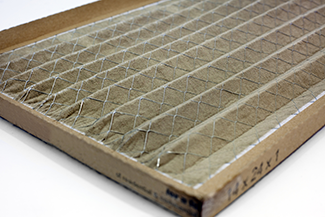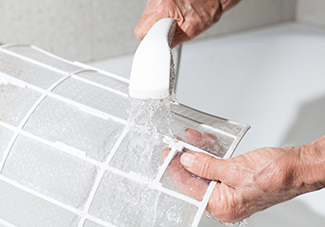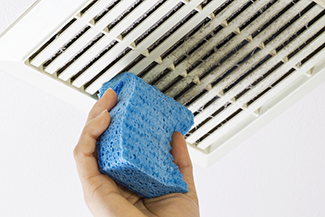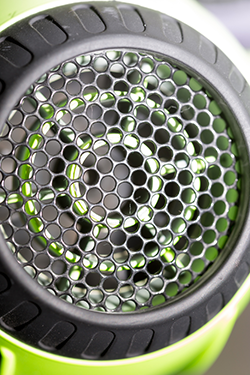Improve Household Air By Cleaning and Replacing Air Filters
Improve Household Air By Cleaning and Replacing Air Filters
One of the simplest tasks to keep your home and its equipment working properly is to clean the air filters. When we think of air filters, most of us generally think of the HVAC filter. While we will start with that one, there are a few more to add to the maintenance schedule.
Heating & Cooling System’s Air Filter
REEIS Air Conditioning, a Rosie-Certified Partner, recommends replacing air filters once a month throughout the year. If you listen to our broadcast, you'll hear Rosie recommend the same thing everytime the topic comes up.
Finding & Replacing Your Air Filter
 Filters are often located in ceilings or walls along the path of the ductwork that returns air to the air conditioning unit. Not to be confused with the air vent, look for a removable metal cover in the ceiling, or low on a wall. Once you've found it:
Filters are often located in ceilings or walls along the path of the ductwork that returns air to the air conditioning unit. Not to be confused with the air vent, look for a removable metal cover in the ceiling, or low on a wall. Once you've found it:
- Open the metal cover, remove the old filter, and measure it. A lot of the time, the size is printed along the edge of the filter as well.
- Buy a replacement filter the same size as the old one (as long as the old one fits). A good filter should run around $4.
- There will be an arrow on the side of the filter telling you which way the airflow is supposed to go through the filter. Install the new filter according to that airflow arrow.
- Reinstall the metal cover.
- Remove dust bunnies from the vent with a vacuum or slightly damp cloth.
- Dispose of the old filter.
- Repeat the process every month because our dusty Arizona air makes filters extra-dirty. Therefore, they need to be changed more often.
- Clean each the air vents to remove any lingering dust.
For a window or wall mount air conditioner:
 The filter is located inside the unit.
The filter is located inside the unit.
- Turn off the air conditioner.
- Take the cover off of the front of the air conditioner; it may pop off, or you may need to unscrew it. The filter is behind it.
- Remove the filter. You might be able to push it out, but some models are screwed in.
- Most window and wall mount A/C filters are reusable. Instead of replacing the filter, you will clean it. Shake or vacuum the dust off and rinse with soapy water.
- After the filter is completely dry, place it back into the unit.
- Replace the front cover.
- Wipe down the front of the unit.
Mini Split
Check the mini-split filters every two weeks and see if they need cleaning. Dirt, debris, and mold can accumulate quickly.
To clean mini-split filters, power down the entire system. Let everything cool down. When it is cool, take off the panel of the unit. Wipe away dust with a cloth.
Then remove the filter. With warm water and dish soap, clean both sides of the filter. Rinse off soap residue and put the filter in the shade to air dry. When it is completely dry, place it back in the unit.
Bathroom Fans

To keep your bathroom fans working efficiently, give it a thorough cleaning every six months. Be sure the power to the fan is off before removing the cover. Clean the cover and the fan. A dirty fan can’t clear out moisture, which eventually will lead to mold and mildew.
Dryer Filter
Always clean the lint filter between every batch of clothes. Get into the habit of removing lint from the screen, either before or after every batch. Many new dryers will automatically remind you to check the lint filter before starting up.
Vacuum Filter
If your vacuum isn’t suctioning like it used to or stinks when turned on, it’s time to clean or replace the air filter. Bagless vacuums need more frequent filter changes and cleanings. Unless the manufacturer says otherwise, replace the filters on bagless vacuums every three months.
Bissell notes that foam vacuum filters that can be washed should be gently cleaned by hand with warm water and a drop or two of mild detergent. Make sure the vacuum filter is completely dry before being placed back in the vacuum. If a vacuum filter is even a little damp, mold and mildew can grow and your vacuum will stink when you use it next.
Don’t just empty the dirt canister and skip the filters. Plugged filters lead to an overworked motor, which will eventually burn out. Save yourself the cost of replacing the motor (roughly $100) and clean the filter.

Instead of tapping the filter against the inside of a trash can, clean the pleated filter with a shop vacuum. Some pleated filters have a special coating that you can damage, so be gentle with the shop vacuum nozzle. Clean prefilter screens and post-filters the same way.
If it is not already in the vacuum, insert a certified True High-Efficiency Particulate Air (HEPA) filter to remove invisible particles and allergens. Make sure the word “True" is on the label.
Buy high-quality vacuum bags such as cotton-lined paper bags or synthetic cotton HEPA bags. Bag capacity matters. Higher-capacity bags capture more tiny particles.
Bidet Filter
The carbon air filters should last a few years or longer on most units, depending on the amount of use it gets. Some filters are designed to last for the life of the unit. Check with the bidet’s manufacturer for recommendations or let your nose notify you of the replacement time. Refer to the bidet’s manual for instructions to clean or change the filter.
Air Purifier Filter
Some models come equipped with washable or permanent filters. These filters still need to be cleaned to maintain their effectiveness.
In general, air purifier filters should be changed:
- HEPA Filters: every 12 to 18 months
- Carbon Filters: three to six months
- Pre-Filters: cleaned every 30 days and replaced when worn out
- Permanent Filters: cleaned every three months and replaced when damaged
Some air purifiers come with filter check indicators that let the user know either through an LED indicator or beeping signals that the filter needs to be replaced or cleaned.
Hair Dryer Filter
 Avoid bad hair days. Hairdryers can overheat or shut down when lint builds up in the filter. If the dryer runs too hot or the airflow is weak, it’s time to clean the filter.
Avoid bad hair days. Hairdryers can overheat or shut down when lint builds up in the filter. If the dryer runs too hot or the airflow is weak, it’s time to clean the filter.
Unplug and remove the filter. Twist the filter to remove it, or you use a screwdriver to pry it open.
Rinse water from the inside of the filter to the outside.
After cleaning the filter, you probably will see the inner screen is still dirty. Usea small brush or toothpick and gently remove debris from the screen. A hand vacuum cleaner works well, too.
When the filter is dry, put it back. Plug the dryer in and turn it on to high speed. Wait a few minutes until the dryer pushes all the debris out before using it.
Litter Box Filter
If your cat uses a box with a hood, Chewy.com recommends changing the carbon filters every three to four months depending on how frequently the litter box gets used. Though, it is really a personal preference. If you notice a strong odor coming from the unit, it may be time to change the carbon filter.
Car Filters
Edmunds.com recommends that you check your vehicle’s owner's manual for the manufacturer's recommended intervals. A good rule of thumb is air filter replacement every 12 months or 12,000 miles (whichever comes first). Fuel filter replacement every two years or 24,000 miles (whichever comes first).
Remember to change the cabin filter, too. That filter cleans the air that comes into the interior through the heating, ventilation, and air-conditioning system. When clogged, it can make the car smell unpleasant.
Check the maintenance schedule in your owner’s manual as to when the cabin filter should be changed. If you live in an area t has poor air quality and a lot of dust, it may need to be replaced annually or more often.
Water Filter
Many homeowners say they can notice a change in their water's taste if they haven't changed the filter regularly.
For a reverse osmosis system, refer to the owner's instruction manual. Some filters and membranes can last as long as two years, but some need replacing before that.
The same is true for refrigerator filters, but generally, most of them can last about six months. Refrigerator filters clear contaminants by forcing water through activated carbon filters. But once that carbon gets covered with contaminants, the water passes through untreated.
Filters in pitchers or carafes often need changing every two to five months.
Home Maintenance To-Do | #AirFilters
Podcast
We cover the Weekly To Do on air filters; there are many to consider besides your A/C Heating unit. Most Asked Question Of Week on 'faux wood' floors: what choices do you have for the look of wood with less maintenance. Plus listener questions on treating termites, attaching furring strips to block walls and the proper way to seal pavers.
###
Photo Credit
- Shutterstock
Related Content
- DIY FAQ: If You "Treat" Your Drinking Water, Keep Changing The Filter
- DIY FAQ: Maintain Proper Air Supply By Regularly Changing The Filter
- DIY FAQ: How Can i Clean The Air In My Home?
- DIY FAQ: Which Is The Best Air Conditioning Filter For My Home?
- External Resource: How Often Should You Clean Mini Split Filters?
- External Resource: Clean Hair Dryer
- External Resource: How Often Should i Change My Air Purifier Filter?
